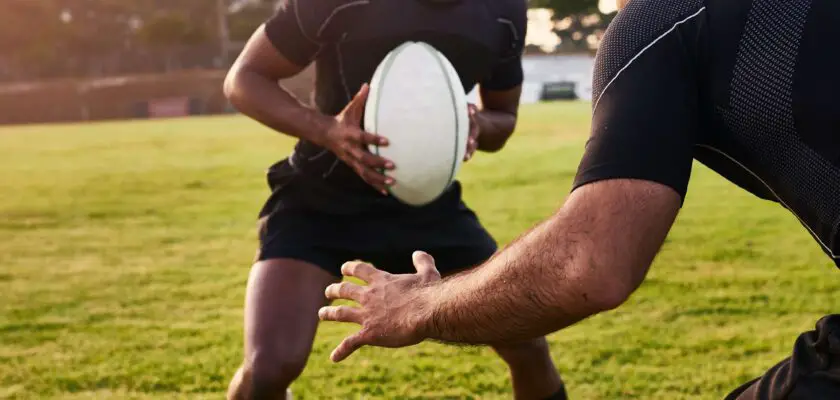In rugby, there are different types of passes that players use to move the ball around the pitch and towards the goal. In this complete guide, we present all the passes in rugby. Get to know the rules and answer all your questions!
Open your Betano account and get up to 1,000 reais in bonuses.
PIX payments, live games and super odds!
Click here to open your account!
Passes in rugby
Chest pass
The chest pass is the most basic and common type of pass in rugby. The player holds the ball with both hands at chest height and passes directly to a nearby teammate.
Overhead pass
Similar to the chest pass, but instead of passing at chest height, the player passes the ball above their head. This is useful for getting past defenders or reaching players further away.
Shoulder pass
Another of rugby’s passes is the shoulder pass, where the ball is passed from one hand to the other at the player’s shoulder level. It’s useful for throwing the ball quickly to a nearby player, without wasting time holding the ball in both hands.
Behind-the-back pass
A less common pass, where the player passes the ball behind his back to a teammate. It is usually used to surprise the defense or to avoid tackles.
Hook pass
The hook is a pass in which the player uses a “hooking” movement with his hands to throw the ball to a teammate. It is often used when the player is under pressure and needs to pass the ball quickly.
Pop pass
A short, quick pass used when a player is about to be tackled. The player holds the ball and, on being tackled, passes the ball quickly to a nearby teammate.
Underhand pass
Rugby passes also include the underhand pass, which is similar to the pop pass, but the ball is passed from the bottom to the top, with the hands under the ball. It’s useful for short, quick passes.
Kick pass
Although not strictly a traditional pass, sometimes players use their feet to kick the ball to a teammate. This is common in open play situations or to advance the ball into the opponent’s half.
Offload
Also known as “offloading”, this is not a traditional pass, but a technique where the player, when tackled, tries to transfer the ball to a teammate before being taken to the ground. This is done to maintain the momentum of the play and continue the advance.
Reverse shoulder pass
Similar to the shoulder pass, but executed in reverse, where the player throws the ball behind the opposite shoulder to the one holding the ball. It is used to deceive the defense and find space for the pass.
Bounce pass
Used occasionally, especially in adverse playing conditions (such as heavy rain), where the player passes the ball on the ground with a slight bounce to a nearby teammate. This can be safer than a high pass in situations of compromised visibility.
Heel pass
Rarely seen, this is when a player uses his heel to pass the ball to a teammate. This can be used to surprise the defense or as a last resort when the player is being pressured from the front.
Pressure pass
A quick, short pass used when the player is under imminent pressure of being tackled. It’s a quick and accurate passing technique to avoid losing the ball.
Reverse hook pass
Similar to the hook pass, but executed in reverse, where the player uses a “hooking” movement with their hands to throw the ball to a teammate. It can be used to pass the ball quickly in unexpected directions.
Dribble pass
Another of rugby’s passes, in the dribble pass the player passes the ball while still in motion, dribbling with his feet. It’s less commonly used, but can be an effective way of keeping possession of the ball while moving forward.
Top pass
Used mainly in ruck or scrum situations, where the ball is passed backwards to a support player near the top of the formation. It’s a quick, short passing technique.
Sideways hook pass
Similar to the hook pass, but performed sideways instead of forward. Can be used to pass the ball to a teammate positioned sideways.
Spin pass
A type of pass where the player spins the ball quickly when passing it. This is done by applying a rotation effect to the ball to increase the speed and accuracy of the pass.
Jump pass
A pass made while the player is in the air, usually used to pass the ball over defenders or to avoid tackles.
Through-the-legs pass
A less conventional technique among rugby passes, where the player passes the ball between his own legs to a teammate. It can be used to surprise the defense.
Now that you know the passes in rugby, how about seeing more about this fascinating sport? Follow our content:



